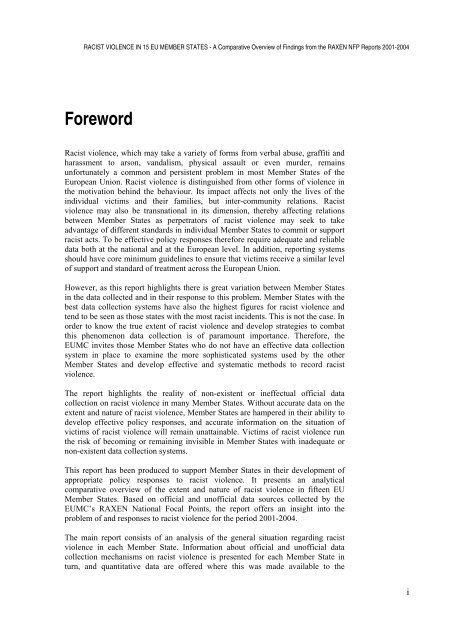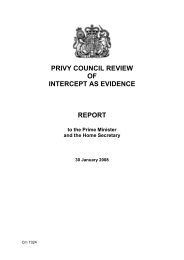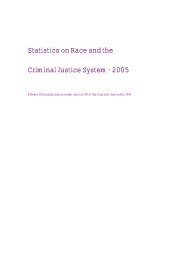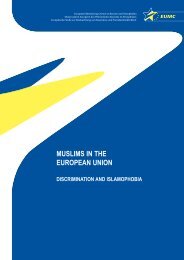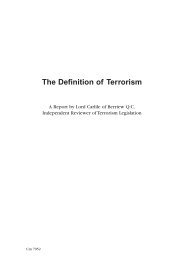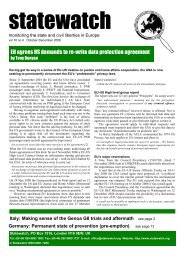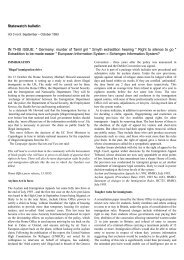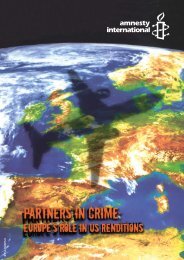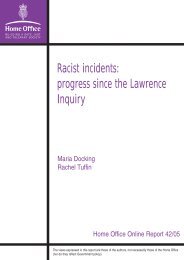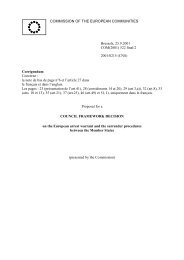RACIST VIOLENCE IN 15 EU MEMBER STATES - Cospe
RACIST VIOLENCE IN 15 EU MEMBER STATES - Cospe
RACIST VIOLENCE IN 15 EU MEMBER STATES - Cospe
Create successful ePaper yourself
Turn your PDF publications into a flip-book with our unique Google optimized e-Paper software.
<strong>RACIST</strong> <strong>VIOLENCE</strong> <strong>IN</strong> <strong>15</strong> <strong>EU</strong> <strong>MEMBER</strong> <strong>STATES</strong> - A Comparative Overview of Findings from the RAXEN NFP Reports 2001-2004<br />
Foreword<br />
Racist violence, which may take a variety of forms from verbal abuse, graffiti and<br />
harassment to arson, vandalism, physical assault or even murder, remains<br />
unfortunately a common and persistent problem in most Member States of the<br />
European Union. Racist violence is distinguished from other forms of violence in<br />
the motivation behind the behaviour. Its impact affects not only the lives of the<br />
individual victims and their families, but inter-community relations. Racist<br />
violence may also be transnational in its dimension, thereby affecting relations<br />
between Member States as perpetrators of racist violence may seek to take<br />
advantage of different standards in individual Member States to commit or support<br />
racist acts. To be effective policy responses therefore require adequate and reliable<br />
data both at the national and at the European level. In addition, reporting systems<br />
should have core minimum guidelines to ensure that victims receive a similar level<br />
of support and standard of treatment across the European Union.<br />
However, as this report highlights there is great variation between Member States<br />
in the data collected and in their response to this problem. Member States with the<br />
best data collection systems have also the highest figures for racist violence and<br />
tend to be seen as those states with the most racist incidents. This is not the case. In<br />
order to know the true extent of racist violence and develop strategies to combat<br />
this phenomenon data collection is of paramount importance. Therefore, the<br />
<strong>EU</strong>MC invites those Member States who do not have an effective data collection<br />
system in place to examine the more sophisticated systems used by the other<br />
Member States and develop effective and systematic methods to record racist<br />
violence.<br />
The report highlights the reality of non-existent or ineffectual official data<br />
collection on racist violence in many Member States. Without accurate data on the<br />
extent and nature of racist violence, Member States are hampered in their ability to<br />
develop effective policy responses, and accurate information on the situation of<br />
victims of racist violence will remain unattainable. Victims of racist violence run<br />
the risk of becoming or remaining invisible in Member States with inadequate or<br />
non-existent data collection systems.<br />
This report has been produced to support Member States in their development of<br />
appropriate policy responses to racist violence. It presents an analytical<br />
comparative overview of the extent and nature of racist violence in fifteen <strong>EU</strong><br />
Member States. Based on official and unofficial data sources collected by the<br />
<strong>EU</strong>MC’s RAXEN National Focal Points, the report offers an insight into the<br />
problem of and responses to racist violence for the period 2001-2004.<br />
The main report consists of an analysis of the general situation regarding racist<br />
violence in each Member State. Information about official and unofficial data<br />
collection mechanisms on racist violence is presented for each Member State in<br />
turn, and quantitative data are offered where this was made available to the<br />
i


